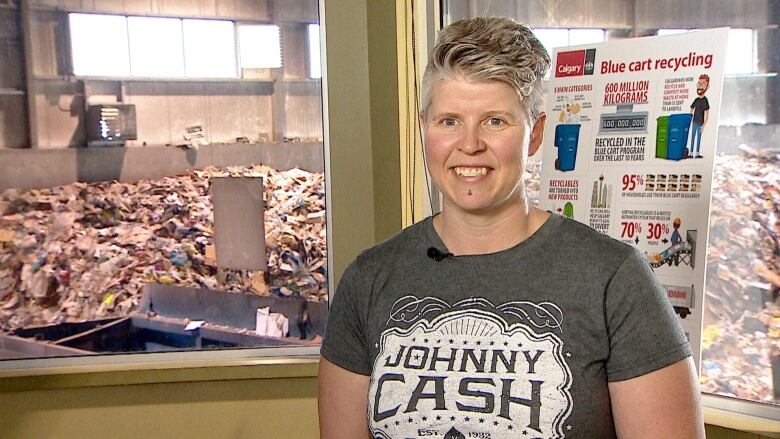Don't bag your recycling, and other tips for Calgary's 10th blue cart anniversary
Here's what can and can't be recycled

It's been a decade since Calgary launched its blue cart recycling program.
Since then, the cityhas recycled more than 600 million recyclables enough to fill the Bow skyscraper downtown more than eight times.
The city services about 330,000 households weekly. and 95 per cent of them regularly use their blue carts.
The paper recycled in the blue cart program saves a million trees a year, according to the city.
It also points out that ittakes 95 per cent less energy to recycle tin cans and 70 per cent less energy to recycle plastic containers than to make products from raw materials.
There have been some issues, like the city having to pay hundreds of thousands of dollars to store more than 100 trailer loadsof clamshell packaging the kind that holds strawberries and baked goods in many stores, for example after China stopped accepting it.
Calgary has found a buyer for all of the clamshells that come in moving forwardalthough it's still looking for a long-term solution to rid itself of its enormous plastic stockpile.
But the city says it's still working on one big goal to decrease the amount of unsuitable materialthat ends up in blue carts, contaminating the other recycling so it gets thrown out instead of repurposed.
12-15% of recycling contaminated
Sharon Howland with the city's waste and recycling services says 12 to 15 per cent of recycling is contaminated with the wrong materials, and that number has gone up in recent years, possibly due to packaging changes.
"Our greatest challenge is making sure people know what to put in the carts and put the right things in it's primarily equipment that sorts materials, and it's only able to sort the right materials," she says.
Those wrong materials can be dangerous, like a compressed cylinder that could cause an explosion, damage equipment and hurt employees, says Howland.
"So it's very important that we only put the right things in our blue carts."
A full list of what can and can't be recycled is on the city's website, but Howland broke down a few of the top misconceptions about what's allowed.
Yes, these go in the blue bin:
- Delivery boxes, flattened out.
- Cartons, milk or stock.
- Shredded paper, but with a caveat: it must be in a clear pastic bag, tied shut.
- Stretchy plastic bags, bread bags and ziploc bags. But, like the shredded paper, it all needs to be in one bag tied up. That's because it's so light it gets stuck with paper while being sorted.
- Cans and foil, rinsed off and dried.
- Clean food jars, label on or off.
- Plastic containers, rinsed and dried.
No, these don't go in the blue bin:
- Aerosol cans. You can dispose of these for free athousehold hazardous waste drop-off locations in Calgary: a designated fire hall or a city landfill's Throw 'n' Go area.
- The same goes for propane tanks, with some restrictions.
- Likewise jerry cans and other fuel containers (empty or filled).
- Batteries. The city says you can take non-rechargeable batteries to a participating retailer for recycling, free of charge. This includes lithium primary batteries and alkaline/single-use household batteries.
- Electronics. Depends what they are but don't throw any in the trash without first checking the city's electronics recycling list.
- Clothing. Many local charities accept reusable clothes, shoes and damaged textiles. The city also offers free textile recycling for clothing and textiles, even damaged goods.
- Toys. You can donate useable toys to participating charities, listed inAlberta's Recycling Hotline. Unusable toys, even plastic ones, should be put in the black cart as garbage.
- DVDs, CDs and Blurays. Usable media discs can be donated to participating charities or possibly sold to second-hand stories but old and broken ones should go in the black cart as garbage.
- Polystyrene foam, like take-out containers, foam meat trays (and absorbent pads), shipping material like foam blocks and peanuts, all go in the garbage even if marked with a recycling symbol.
- If you're not sure where to put an item, you can search the city's What Goes Where online tool.
Another important tip is how the recycling should be put in the blue bin. Unlike other cities such asEdmonton, Calgary only accepts loose recyclables. So don't bag them up first;just put them in loose.
Howland says that's because the facility isn't designed to open bags, and with 40 tonnes being processed every hour, there's just no time.
Every tonne of plastic recycled saves a tonne of carbon dioxide emissions.
But even better than recycling, Howland says, are the other two Rs: reduce and reuse.
"Recycling is the most popular of the three Rs, but it's definitely not the most effective."
Corrections
- An earlier version of this story said aerosol cans, batteries, propane tanks, jerry cans, electronics and clothing could go in the black carts as garbage under Calgary's waste management program. In fact, the subheadline should have said those items are some of the most common to be incorrectly deposited in the blue bin when they should be disposed of in other ways.Jul 03, 2019 8:18 AM MT
With files from Monty Kruger












_(720p).jpg)


 OFFICIAL HD MUSIC VIDEO.jpg)
.jpg)



























































































